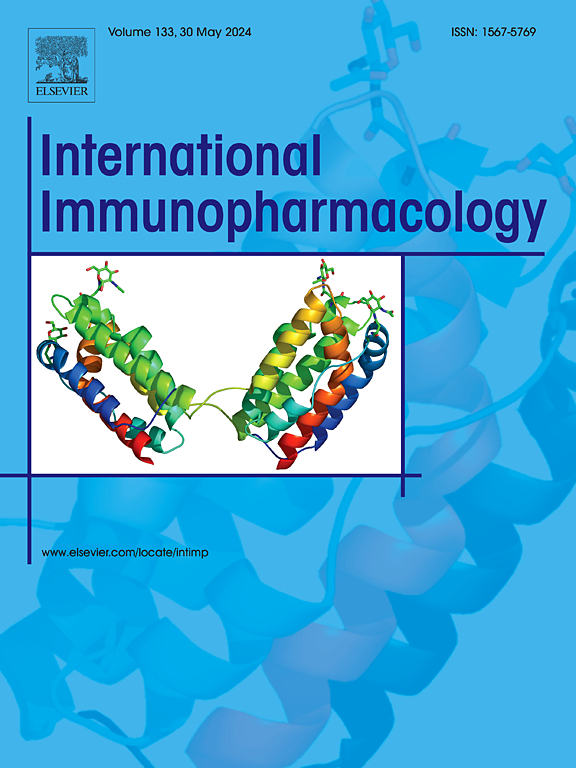1,25-二羟基维生素D3通过影响FoxO1和p-Smad3的相互作用减轻1型糖尿病相关的心肌凋亡和纤维化
IF 4.8
2区 医学
Q2 IMMUNOLOGY
引用次数: 0
摘要
糖尿病性心肌病是糖尿病最重要的并发症之一。维生素D缺乏进一步增加糖尿病患者心力衰竭(HF)和死亡的风险。本研究旨在通过影响FoxO1和p-Smad3的相互作用,探讨1,25 d3在缓解1型糖尿病相关心肌凋亡和纤维化中的作用。首先,我们发现在社区居住的老年人中,维生素D缺乏增加了与HbA1c升高相关的HF的风险。1,25 d3在链脲佐菌素诱导的1型糖尿病小鼠模型中部分改善心功能和组织学结构改变,降低心肌凋亡和纤维化蛋白的表达水平。在H9c2细胞中,1,25 d3处理以剂量依赖的方式抑制高糖(HG)诱导的凋亡和纤维化标记蛋白的表达。此外,1,25 d3处理在体内和体外抑制hg刺激的FoxO1和Smad3信号传导。然而,1,25 d3的心脏保护作用被FoxO1过表达消除。共免疫沉淀实验表明,p-Smad3和FoxO1蛋白与1,25d3或FoxO1抑制剂AS1842856 (AS)的相互作用可以有效抑制这种关联和纤维化基因Col-1的mRNA水平。我们的数据表明,1,25 d3通过抑制FoxO1和p-Smad3之间的相互作用来减轻DCM的心肌凋亡和纤维化。这项研究提出了一种新的机制,并有力地支持了1,25 d3作为DCM治疗剂可能有效的观点。本文章由计算机程序翻译,如有差异,请以英文原文为准。
1,25-dihydroxyvitamin D3 attenuates type 1 diabetes-related myocardial apoptosis and fibrosis by influencing the interaction of FoxO1 and p-Smad3
Diabetic cardiomyopathy (DCM) is one of the most important complications of diabetes. Vitamin D deficiency further increases the risk of heart failure (HF) and death in patients with diabetes. This study aimed at investigating the role of 1,25D3 in alleviating type 1 diabetes-related myocardial apoptosis and fibrosis by influencing the interaction of FoxO1 and p-Smad3. First, we found that vitamin D deficiency augments the risk of HF associated with elevated HbA1c in community-dwelling older adults. 1,25D3 partially ameliorated cardiac function and histological structural changes and reduced the expression levels of myocardial apoptosis and fibrosis proteins in streptozotocin-induced type 1 diabetes mouse model. In H9c2 cells, 1,25D3 treatment inhibited the expression of apoptosis and fibrosis marker proteins induced by high glucose (HG) in a dose-dependent manner. In addition, 1,25D3 treatment inhibited HG-stimulated FoxO1 and Smad3 signalling in vivo and in vitro. However, the cardioprotective effects of 1,25D3 were eliminated by FoxO1 overexpression. The co-immunoprecipitation experiments demonstrated that the interaction between p-Smad3 and FoxO1 proteins and 1,25D3 or FoxO1 inhibitor AS1842856 (AS) treatment could effectively suppress this association and the mRNA level of fibrotic gene Col-1. Our data suggest that 1,25D3 attenuates myocardial apoptosis and fibrosis in DCM by inhibiting the interaction between FoxO1 and p-Smad3. This study proposes a new mechanism and strongly supports the idea that 1,25D3 may be effective as a therapeutic agent for DCM.
求助全文
通过发布文献求助,成功后即可免费获取论文全文。
去求助
来源期刊
CiteScore
8.40
自引率
3.60%
发文量
935
审稿时长
53 days
期刊介绍:
International Immunopharmacology is the primary vehicle for the publication of original research papers pertinent to the overlapping areas of immunology, pharmacology, cytokine biology, immunotherapy, immunopathology and immunotoxicology. Review articles that encompass these subjects are also welcome.
The subject material appropriate for submission includes:
• Clinical studies employing immunotherapy of any type including the use of: bacterial and chemical agents; thymic hormones, interferon, lymphokines, etc., in transplantation and diseases such as cancer, immunodeficiency, chronic infection and allergic, inflammatory or autoimmune disorders.
• Studies on the mechanisms of action of these agents for specific parameters of immune competence as well as the overall clinical state.
• Pre-clinical animal studies and in vitro studies on mechanisms of action with immunopotentiators, immunomodulators, immunoadjuvants and other pharmacological agents active on cells participating in immune or allergic responses.
• Pharmacological compounds, microbial products and toxicological agents that affect the lymphoid system, and their mechanisms of action.
• Agents that activate genes or modify transcription and translation within the immune response.
• Substances activated, generated, or released through immunologic or related pathways that are pharmacologically active.
• Production, function and regulation of cytokines and their receptors.
• Classical pharmacological studies on the effects of chemokines and bioactive factors released during immunological reactions.

 求助内容:
求助内容: 应助结果提醒方式:
应助结果提醒方式:


